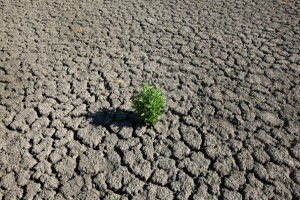How The Oceans Have Dried Texas Out

Photo by Scott Olson/Getty Images
A weed grows out of the dry cracked bed of O.C. Fisher Lake in July. The drought has taken a severe toll on Texas' lakes and rivers.
Over the last several years, climate patterns from the Atlantic and Pacific Oceans have exacerbated the historic Texas drought. A reverse in those patterns could bring Texas abundant rains over the next couple decades, according to State Climatologist John Nielsen-Gammon.
But, Nielsen-Gammon says, long term trends give Texans no reason to break out the champagne. Global climate change means the next major drought could be even worse than this one.
The Texas climate is sensitive to weather cycles in the Atlantic and Pacific Oceans, and neither has favored precipitation in the state since 2005. “The Pacific Ocean has been unfavorable for rainfall since about 2000 or 2005. The Atlantic Ocean has been unfavorable since 1995,” Nielsen-Gammon said.
The combined effects of the two cycles, called the Atlantic Multidecadal Oscillation and the Pacific Decadal Oscillation, can limit or increase rainfall in the state by as much as twenty percent.
Historical patterns suggest that the two oscillations cycle between favoring dry and wet Texas weather every thirty or so years. Nielsen-Gammon says the state is now emerging from a dry period.

Photo courtesy of Texas A&M University
John Nielsen-Gammon, the state climatologist, says Texas is facing a 50-50 chance of being in another drought of record.
But future droughts are expected to be more severe as climate change makes Texas hotter, and causes surface water to evaporate more quickly. Evaporation rates increase by about five percent for every degree Fahrenheit rise in the annual temperature. Climate models predict that the state will be 0.5 – 2 degrees hotter at the cusp of the next dry cycle, in thirty years.
Texas temperatures had trended downwards through the 20th century until the 1970s, the coldest decade in most of the southern United States. They have rebounded steeply since then, surpassing the historical norm about fifteen years ago. The state is on average 1.5 degrees hotter now than it was four decades ago.
Nielson-Gammon says climatologists aren’t sure how the Atlantic the Pacific oscillations will respond to climate change, but it is unlikely that Texas will receive enough precipitation to offset the faster surface water evaporation rates.
One thing that appears to be helping keep moisture in Texas soil is the way plants are adapting to climate change.
Plants draw water from the soil to survive but release most of it through their pores, which they open to take in carbon dioxide. This process, called transpiration, is responsible for a significant portion of surface water evaporation. As atmospheric concentrations of the carbon dioxide rise, plants don’t have to keep their pores open as long, reducing the amount of water lost to the atmosphere.The atmospheric concentration of carbon dioxide has risen by 17 percent globally since 1980, according to the National Oceanic and Atmospheric Association (NOAA). To learn how scientist measure the amount of CO2 pumped into the atmosphere click here.
As far as what to expect from the weather this summer?
“I basically don’t do summer forecasts,” says Neilsen-Gammon. “I just say, It’s gonna be hot. And leave it at that.”
Seems like a safe bet.

